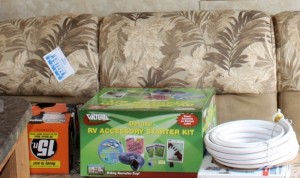Outfitting a Camper
It has been over a year since we bought our Jayco 26BH. When I started shopping for a camper, I really had no idea what it would take to get properly outfitted and ready for our adventures.
I did a lot of research; talking to experienced campers and asking questions on the Trailer Life forums. After learning everything I could, I put together a purchase offer for our camper. A year later, after camping in a wide range of campgrounds, I can report on what was useful and what was missing.
First, think of outfitting a camper kind of like setting up a small home or apartment. Most of what you use in the kitchen, bedrooms, and yard at home you will probably use in a camper. However, there are some unique items that you may not think of from home like special power cords or water hoses.
I will leave you to think about the basics for the kitchen. However, we have found a few items we use in the camper that we didn’t use at home. Collapsable bowls and a colander are helpful. Foam beverage Koozies are nice to have. We also found collapsable trash cans to be a good idea. We even have a broom with a telescoping handle to save space. For now, we have just been borrowing pans, cooking utensils, and other kitchen items from home; adding a few items at a time until we have a full duplicate set. It helps to try things out in the camper before you buy a full set of everything from home.
The shopping list for outside the camper is a bit longer. It includes:
- White drinking water hoses; 2X25 feet
- A general purpose hose; 1X25 feet
- An adjustable flow water pressure regulator with gauge. For example, one from Valterra. Note the basic pressure regulators are often marked with ‘contains lead – not for drinking water’. Pressure varies from campground to campground. It is nice to be able to adjust the flow.
- A water thief. This allows you to connect your water hose to a pipe that isn’t threaded. I have not had to use mine yet but have heard it can come in handy for filling your tanks.
- An upgraded slinky hose. For example, the RhinoFlex RV Sewer Kit. Some campgrounds require your hose to connect in to the sewer pipe. It is good to have one with an elbow that screws in. You might consider a riser to rest your hose on, too. Some campgrounds require it to be kept off the ground.
- Power adapters for 20, 30, and 50 amp service. We have frequently needed the 20 amp adapter. Haven’t yet needed a 50 amp, but it is good to be prepared.
- A power extension cord. In some cases, the utilities are not located in a conveniently for your camper. I have needed an extension on a few occasions. Get the heavy duty extension cord that matches your camper’s cable, not an orange cord like you might use at home. Regular outdoor extension cords are also useful. We have one that is used to connect our fun awning lights.
- A 25 foot coax TV cable.
- Wheel chocks. I got a set of Lynx orange chocks. So far, they have worked well.
- Lynx leveling blocks. You can use any kind of leveling blocks. You can even use spare pieces of wood. The Lynx blocks are nice as they can be stacked to easily level the camper. They can also lock in to the chocks. That said, I also carry some scrap wood which I use under the hitch in front – there are times when you need a few extra inches.
- A sway control hitch. I have the Husky Centerline and it has performed very well.
- A trailer brake. My tow vehicle has this feature built in which is really nice. Otherwise, you will have to install one.
Depending on where you are going to camp, you may need to improve the electrical system. We added a second battery and battery box. This enables us to go a bit longer without hookups. I considered a generator but I have found that I really haven’t needed it, even going six nights in a national park without hookups. But, you can’t run the AC without hookups or a generator – so you may have different needs.
We have a large folding table and a screen tent. So far we have only used these once. Most campgrounds provide a picnic table that works well. Just bring along a table cloth and some clips to hold it on to the table.
A few more things for inside the camper:
- Sheets and pillows for the beds. Camper beds aren’t a standard size. We just use flat sheets rather than fitted and it works fine. If you are going to camp where it is cold, bring a blanket or two.
- Some rugs for the floor are nice. A bonus is that they can be used on warm days to cover the floor vents so things don’t fall in. Just remember to move them if you need to turn the heater on.
- Bug traps aren’t a bad idea. We haven’t had any problems and would like to keep it that way. Also, many people suggest placing Bounce dryer sheets in several places to keep pests away.
- RV suitable toilet paper.
- Holding tank chemicals. We like the pellet kind. You just drop one in along with a gallon or so of water. Haven’t had a problem so far.
I hope this post was useful. However, I am sure I have forgotten something. What are your ‘must have’ camper items? Let me know by posting a comment.
Copyright 2011. All Rights Reserved.

